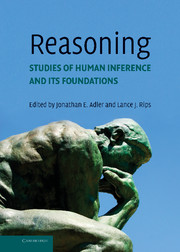Book contents
- Frontmatter
- Contents
- Preface
- List of Contributors
- Introduction: Philosophical Foundations
- PART I FOUNDATIONS OF REASONING
- PART II MODES OF REASONING
- PART II INTERACTIONS OF REASONING IN HUMAN THOUGHT
- Section 9 Reasoning and Pragmatics
- Section 10 Domain-Specific, Goal-Based, and Evolutionary Approaches
- Section 11 Reasoning and Cultures
- Section 12 Biology, Emotions, and Reasoning
- 51 Logic and Biology: Emotional Inference and Emotions in Reasoning
- 52 Distinct Brain Loci in Deductive versus Probabilistic Reasoning
- 53 The Emotional Dog and Its Rational Tail: A Social Intuitionist Approach to Moral Judgment
- Index
- References
51 - Logic and Biology: Emotional Inference and Emotions in Reasoning
Published online by Cambridge University Press: 05 June 2012
- Frontmatter
- Contents
- Preface
- List of Contributors
- Introduction: Philosophical Foundations
- PART I FOUNDATIONS OF REASONING
- PART II MODES OF REASONING
- PART II INTERACTIONS OF REASONING IN HUMAN THOUGHT
- Section 9 Reasoning and Pragmatics
- Section 10 Domain-Specific, Goal-Based, and Evolutionary Approaches
- Section 11 Reasoning and Cultures
- Section 12 Biology, Emotions, and Reasoning
- 51 Logic and Biology: Emotional Inference and Emotions in Reasoning
- 52 Distinct Brain Loci in Deductive versus Probabilistic Reasoning
- 53 The Emotional Dog and Its Rational Tail: A Social Intuitionist Approach to Moral Judgment
- Index
- References
Summary
The unrefined and sluggish mind of Homo Javanensis Could only treat of things concrete and present to the senses
W. V. QuineTropisms and Transitions: Some Leading Questions
Before planning and reasoning, there were tropisms. Tropisms have functions and make use of information detected, but they don't, I assume, involve any actual reasoning. Somewhere along the course of evolution, and at some time in any one of us on the way from zygote to adult, some forms of detection became beliefs, and some tropisms turned into reasoned desires. And at some stage – perhaps, if Quine is right, with Homo javanensis – we became adept at processing information, that yet fell short of the power to abstract and generalize. What selective pressures can we then suppose to have effected in our brains, since then, the innovations required to bring us the capacity for fully abstract and general reasoning?
I take for granted that reasoning is something we do; that much or most of what we do is influenced by emotion; that psychology is interested in everything we do; and that psychology is a branch of biology. These breezy premises raise a number of questions.
What kind of connection might there be between biology and rationality?
More specifically, how does the normativity of logic relate to its biological origins? Is there not, in the very idea of such a connection, something akin to the naturalistic fallacy?
If our capacity for inference is in part a legacy of natural selection, are there specific emotional mechanisms that serve to influence reasoning at the proximate level?
[…]
- Type
- Chapter
- Information
- ReasoningStudies of Human Inference and its Foundations, pp. 1002 - 1015Publisher: Cambridge University PressPrint publication year: 2008
References
- 3
- Cited by



